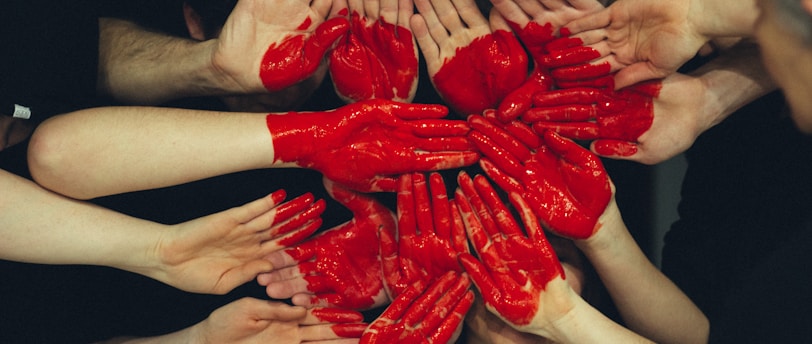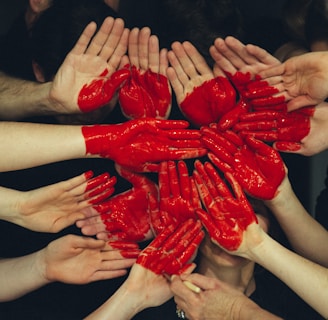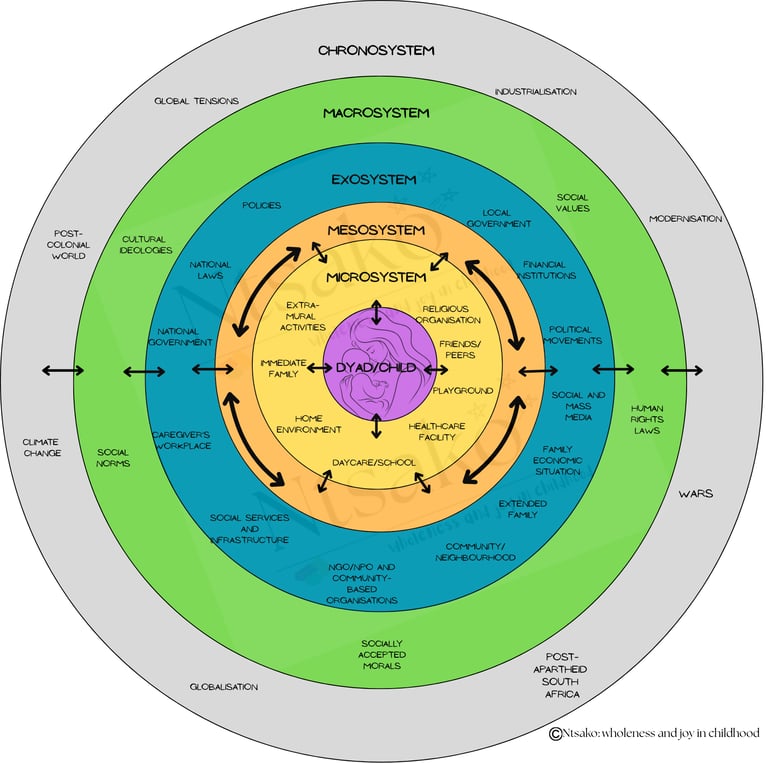
A Person in Context
Part 1.4 The final part of our Issue. A look into a theory/model that shows us just how important the environment around the child is for their development and how everything we have discussed comes together.
ISSUE 1
VJ Tlakula
4/30/20257 min read


A Person in Context
Now that we have established that a child is a complex individual, how we have come to think of them, and how the concept of children and their rights have evolved, this complex idea of a child begins to come together. In later Issues, I will reveal more about how this complex individual develops - a truly beautiful process.
For now, I want to emphasise the point that the child is not an individual living and developing in isolation. Their biological development is always "interacting" with their external environment. For something to "interact" in the way I speak is for it to influence something else and to also be influenced by that something else. So, basically, the environment will influence/affect biological development, and biology can influence the environments the individual is in and how they respond to those environments. It can be a bit complex to understand at first, but we'll take it step-by-step.
The previous parts of Issue 1 have all had to do with the outside world's opinion and treatment of the child in some way or other. Now, we'll see how this external opinion and effect can impact the literal development and overall lifespan of the child and change the future of the world. From how individuals and parents think about and treat them at a personal level, to how society thinks about and treats them, to the social norms, ideas and laws surrounding children at a particular point in time, the environment constantly influences development.
The Bioecological Systems Model
To better conceptualise this influence of the environment, I draw from an important model in psychology. It's not the only model, but is a good and widely-used one. As a Developmental Scientist, who believes in the interaction of many factors in development, one of my favourite models for understanding development in context is Urie Bronfenbrenner’s (1979) ecological systems theory. In this model, Bronfenbrenner states that there are various levels of society (or environmental systems) which are all impacting on a child in one way or another, and the child themselves is acting on these levels in some way. Every single one of these systems, no matter how seemingly distant from the child themselves, is influencing their immediate environment and development. He developed this theory to emphasise that no child (or individual) exists independently of their context. They exist, and therefore grow/develop influenced by, and as a consequence of, the context they exist in.
These levels are called "systems" and there are 4 of them - the Microsystem, Mesosystem, Exosystem, and Macrosystem. Each of these systems are dynamic and complex, in a constant state of change and interaction. In 2006, he revised this theory into a bioecological model which speaks more specifically to how these levels influence development over time. This revised model introduced a 5th layer called the Chronosystem (which all other systems exist in). So now it's not just systems interacting with each other at a single point, but interacting over time and producing an outcome (development influenced by systems). This helps us to understand development (something taking place over time) as impacted on by the environment.
To Bronfenbrenner, and many developmental scientists, there are 4 elements to how development happens: The Person (all unique factors about them). The Context (the different systems of their world existing and interacting). The Process (regular interaction of a person and their context over time - the complex bit that we developmental scientists try to understand). And Time (consideration of the history of the context; how it came to be the way it is; significant events).
He also speaks of something known as a 'dyad'. This dyad is the child and their primary caregiver (the main person taking care of them) right at the centre of the model. They are described as a single unit, almost a single person. Because they are so closely connected and constantly interacting, their relationship becomes its own system which affects them both. Any effect, good or bad, on the child affects the caregiver and vice versa. In the case of the child, this 'dyadic' relationship deeply affects their development even before the rest of the world does. It can act as a protective space from some of the influences of the world, as well as a space to make sense of the world. This is the system most child development studies and intervention work focuses on.
The Different Systems
Working from the innermost circle outwards, let me unpack the systems. Right at the centre is the child or dyad and everything moving outwards is related to them.
The microsystem is the immediate environment of the child or the environment that they are in regular direct contact with. So, their home, immediate family and friends, and school or other community environment. This system is where they learn to understand and navigate the world around them. The mesosystem is the interaction between the child’s microsystems. So basically, where home and church or home and school interact through meetings or people. Whatever happens in one of these microsystems can fundamentally affect what happens in another. So if something affects the daycare (like being closed), it can affect the home (the caregiver needs to find someone to look after the child). Or lessons taught at school/church impact how the family lives at home.
The next level is the exosystem. The exosystem is more the local and national factors outside of the child/dyad's immediate community. These are people and systems not directly interacting with the individual, but who still have an influence on their life in some way or other indirectly. This can include the government, the parents' workplace, and major social systems and institutions like banks, and parliament.
The macrosystem is basically where the ideologies or social values of the country lie in general. They influence how the society functions, especially at the exo- level. For example, social classes, culture, religion of the country can impact what people have access to or what they choose to participate in. It can determine the kinds of information they receive, jobs they choose, their political views and actions, how they raise their children, and what is currently socially/culturally acceptable for them to practice. The list is endless. This macrosystem can affect what gets supported by the government and socially influential organisations/people.
Remember the evolution of the concept of the child and the children’s rights we discussed? These are examples of macrosystem influences which impact on the child. These ideas influence the policies, sociopolitical movements, and laws that get enacted in schools or communities which then affects how the community and individual live and experience the world. Whatever happens here seems distant from the individual but filters down to them and fundamentally affect every part of their lives, whether they want it to or not. However, events, belief changes at personal and community levels are what create norms and social values. So, personal level things eventually filter up to the macro-level fundamentally affecting the functioning of society over time. This makes quite an interesting system.
For me, the macrosystem emphasises the fact that societies are ultimately made up of individual people doing individual things. Yes, 'society' can often function as an abstract, 'out there' kind of idea and organism that's difficult to understand and has its own mind. But this model shows us that ultimately society, its interests, desires, values, and norms are ultimately made up of people. It has people at its heart, and that means that we should take responsibility for social functioning because whether consciously or unconsciously, we are reproducing and perpetuating certain values and norms.
The Chronosystem, the final level, is integral in considering generational transmission of good and bad values but also life outcomes and broader societal changes. Again, ‘How the Concept of the Child has changed' is a good example of the interaction of the chronosystem on children’s lives and development. This is how changes in society like macrosystem level, have an impact on the chronosystem over time. The chronosystem is the place where all the small changes that have affected the broader society change the course of history in massive ways.
For example, it was the modernisation of society brought on by the industrial revolution which changed the way children were socialised. It moved them out of the workplace, made room for children's rights, and brought on more formalised education. The changes in that period of time affected how children experienced their world back then, and how they experience their world's now. Similarly, we are entering a more heavily technology- and AI-influenced and dependent world which is changing the way children are growing up and experience the world. It's the reality of what the world children are growing up in looks like. Whether an apartheid system, war, or extreme national wealth.
Every system exists within the other and things happening in the microsystem can trickle up to even the chronosystem, and vice versa. By understanding this model, we are also able to see how problems can become cycles/patterns that continue in societies for generations.
Although I haven't touched on it much, Bronfenbrenner emphasises that a child is able to act on and influence their environment and respond to it in a way that shows that they are not just a passive recipient of whatever happens around them. Later Issues build on this. Additionally, genetics, biology, and a slightly more complex concept, resilience stop me from being able to say that the child is always the product of their environment or that we can definitively predict their future from it.
The takeaway
This is not a perfect model and there are many who challenge it. The key thing to note is that this model shows us that:
1. Every level of the environment, no matter how distant it seems is crucial to the child's development, which is why protecting children and their childhoods needs to be addressed at all levels and it's no good ignoring the exo-, macro-, or chronosystems just because they seem far away.
2. How a person grows up to think and be is, in many ways, influenced by the state of these levels when they were growing up.
This model is an excellent way of understanding childhood in multiple contexts, because it carries a central truth that can be applied across contexts and even help us with applying our theories of child development and clearly understanding how they become relevant to various contexts. It gives us a slightly less complex way to better think about and understand something as complex as development in context. It can help us to begin to identify parts of our model which need our attention for protecting children, and how everything works together to produce outcomes.
It can be a bit confusing to understand how this model works at first, that is why I have provided a few examples to help us better understand the model and how it gets used in the next piece.


Share your Comments Below!
Please feel free to reach out with any comments, questions, and child-related stories
Celebrating childhood and development
© Ntsako Wholeness and Joy in Childhood 2025. All rights reserved.
Copyright Vutlhari Joy Tlakula 2025. All Rights Reserved.


